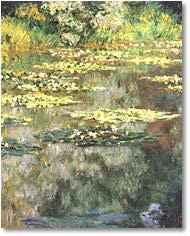
The sacred waterlilies have appeared as capitals of columns in ancient Egyptian temples. The Egyptian priests and rulers were often buried with necklaces of waterlily blossoms, for the lilies symbolized resurrection from the dead. Hindu and Buddhist traditions revere the lotus (Nelumbo) as the womb of gods, and as the symbol of the spiritual ideal. Europeans developed a passion for water gardens around the beginning of the nineteenth century, and the waterlilies often featured prominently in their gardens and art, such as in the Monet painting at right.
Besides their cultural significance, the Nymphaeales provide an important source of food and economic products. The stout tubers of the waterlily and the lotus are edible when properly prepared, and have been an important starch crop both in Asia and North America. The seeds of many species have a fleshy outer covering, which is also edible. In addition, the tubers have been used as a source of dye and for medicinal effects ranging from traditional use as an aphrodisiac to recent use in cancer treatment.
The waterlilies have been around much longer than any human culture, and one view of flowering plant origins maintains that waterlilies and the other paleoherbs are representative of the earliest members of that group.
You may wish to visit the server for the International Waterlily and Water Gardening Society. You may also wish to visit the Victoria Waterlily Web Page, which has a collection of interesting links. Or visit Texas A&M for their Flowering Plant Gateway, with links to relevant on-line materials.
Information about some of the impressionist waterlily paintings by Claude Monet may be found at the Paris Webmuseum.


